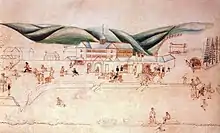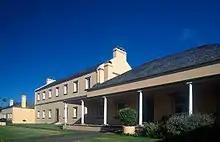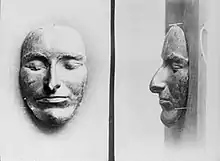Cooking Pot Uprising
The Cooking Pot Uprising or Cooking Pot Riot, was an uprising of convicts led by William Westwood in the penal colony of Norfolk Island, Australia. It occurred on 1 July 1846 in response to the confiscation of convicts' cooking utensils under the orders of superintendent Major Joseph Childs.
| Cooking pot uprising | |||||||
|---|---|---|---|---|---|---|---|
 Watercolour drawing by an unknown artist of the Cooking Pot Uprising | |||||||
| |||||||
| Belligerents | |||||||
|
Van Diemen's Land colonial government | Convicts | ||||||
| Commanders and leaders | |||||||
| Joseph Childs | William Westwood | ||||||
| Strength | |||||||
| Unknown | 1100+[1] | ||||||
| Casualties and losses | |||||||
|
4 constables killed Several wounded |
12 convicts executed Several wounded | ||||||
Background
In February 1844, Childs took over the command of the convict prison settlement at Norfolk Island where he began a regime of harsh discipline that ended with mutiny, massacre, and the execution of 12 men.
His predecessor Captain Maconochie had regarded his prisoners as human beings and permitted them to have small garden plots in which they could grow sweet potatoes and other vegetables. Maconochie also shortened hours of labour, granted holidays for good behaviour and provided saucepans and kettles for prisoners to cook food.
Over a period of two years, Major Childs withdrew those privileges, abolishing private garden plots, lengthening daily hours of work and ending holidays for good behaviour. He cut down the prisoners' rations and, on 1 July, 1846, prohibited personal cooking—ordering all kettles and saucepans held by prisoners to be handed in.[2]
Rebellion

The next day, after a compulsory prayers parade, the convicts went in a body to the lumber yard to read the new proclamation. There were indignant cries. Gathering in rough military formation they marched to the Barrack Yard, stormed the store, and seized every utensil within reach. Westwood hushed them. "Now, men", he said, "I've made up my mind to bear this oppression no longer. But, remember, I'm going lo the gallows. If any man funks, let him stand out. Those who want to follow me – come on!"
And so, the mutiny began. Westwood, his face transformed with rage, struck at a constable who was watching the proceedings. He felled him, and his mates, their pent-up fury now finding a savage outlet, struck at him with knives, sticks, pitchforks – with any weapons they could find.
Then they hurried to the cook house. Here, they found Stephen Smith, the mess overseer. Jacky Jacky attacked him. "For God's sake don't hurt me, Jackey!" he cried out. "Remember my wife and children!" "Damn your wife and children;" said the livid young convict, and knocked him senseless. When the others had finished with him he was a mutilated corpse. The convicts moved on in a wildly rushing mass about 1,600 strong, to the Barrack Yard gate, where they pushed aside a sentry and an overseer who tried to halt them. Their one thought now was to get to Government House, where the main target of their wrath was Mr. Barrow, the Stipendiary Magistrate. As they passed by the lime kiln, Jackey Jackey, now wielding an axe, ran over to a hut, forced open the door, and killed two policemen, one of whom was asleep in his bed.
As they moved down the road towards Government House, they were confronted by a line of soldiers, muskets at the ready. As though the force of their passion had suddenly been spent, the convicts halted, and then began to retreat towards the lumber yard, where their weapons were taken from them, and they were returned to their cells.
John Giles Price was appointed as superintendent to replace Major Childs. One of Price's first duties was to arrange for the trial of 26 convicts alleged to have been involved in murders during the uprising of July 1846 at the end of Childs' administration. Price turned out to be just as inhumane as his predecessor.
Westwood and eleven other leaders of the mutiny were found guilty of murdering police runner Stephen Smith and convict constables John Morris, John Dinon, and Thomas Saxton.
People executed

On 13 October 1846, the twelve convicts were hanged in two groups of six and their bodies were buried in a pit near the pier.
- William Westwood (Jackey Jackey) 26
- John Davis
- Samuel Kenyon
- Dennis Pendergast
- Owen Commuskie
- Henry White 22
- William Pearson
- James Cairnes
- William Pickthorne 27
- Lawrence Kavenagh 41
- William Scrimshaw
- Edward McGinniss [3][4]
References
- "Norfolk Island". Melbourne Argus (Vic. : 1846 - 1848). 14 August 1846. p. 2.
- "Norfolk Island". The Britannia and Trades' Advocate. Hobart Town, Tas. 19 November 1846. p. 3. Retrieved 9 June 2018.
- "Norfolk Island – The Executions". The Australian. Sydney. 28 November 1846. p. 3. Retrieved 29 October 2016.
- "Murder at Norfolk Island". Colonial Times. Hobart, Tas. 25 August 1846. p. 3. Retrieved 29 October 2016.